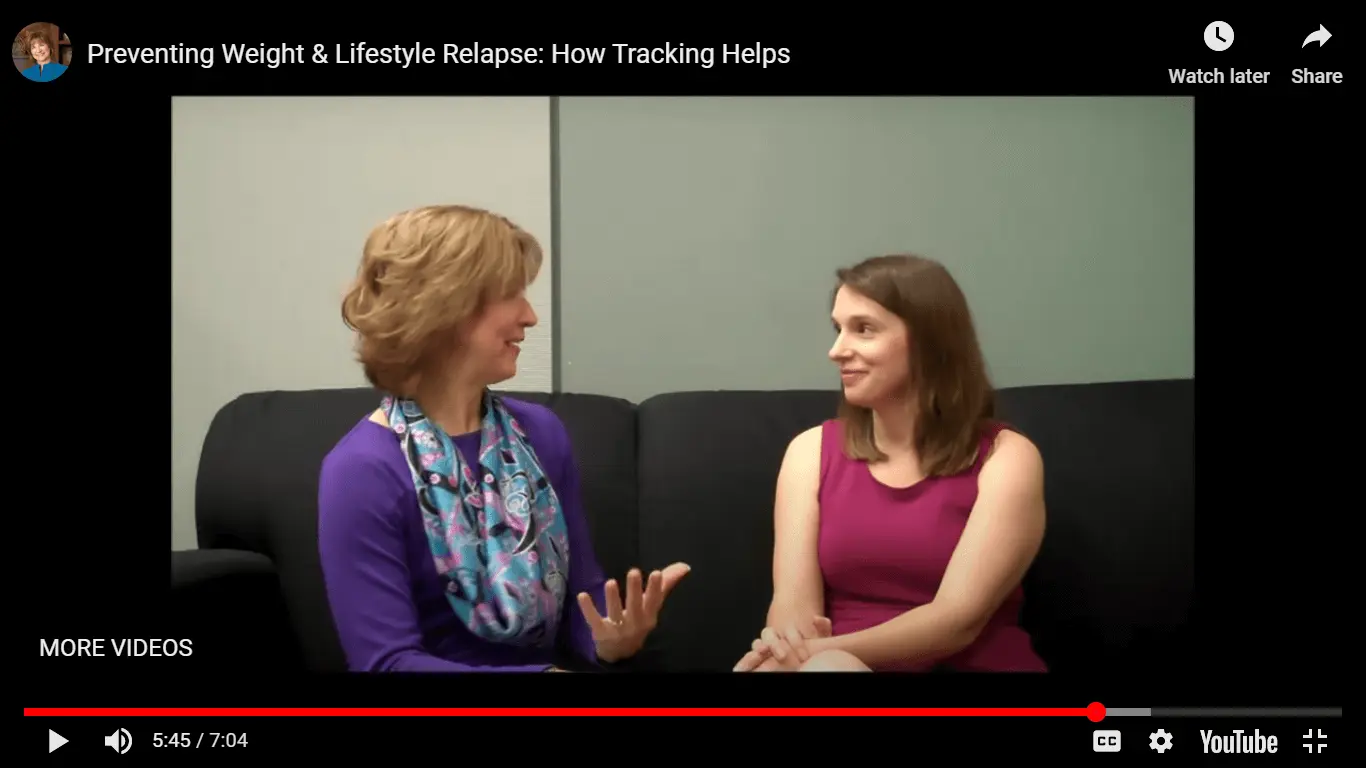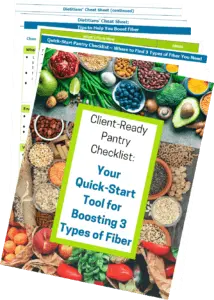
Avoid Weight Loss Relapse: Strategic Synergy
As challenging as it is to lose weight, for many people an even more daunting problem is avoiding, or at least limiting, the weight regain that tends to follow. Metabolic adaptations may account for some weight regain, but many people find that relapse into old habits is clearly involved, too. Is there help beyond ironclad self-discipline?
Tracking your weight and targeting specific changes in eating, exercise and sitting time can both be powerful tools for weight loss. Previous research updates here featured interviews with Rebecca Krukowski, PhD, discussing research on frequency of weight checks and other behavior change tips for weight loss. Dr. Krukowski, a clinical psychologist on faculty at the University of Tennessee Health Science Center in Memphis, provides additional insights on tracking’s role in avoiding relapse in the video interview shared here.
After hearing from Dr. Krukowski, read on for my take on how new research presented an American Heart Association conference I recently attended can address the all-to-common problem of weight loss habits relapse, and help take maintaining a healthy weight from daunting to doable.
Does a Daily Weight Check Thwart Weight Regain?
Daily weight checks’ major benefit may come in their role as reality check. If you start sliding back into habits of higher calorie food and drink choices, larger portions, or giving other choices higher priority than physical activity, the change in balance between calories consumed and used will start to show up as weight gain. This can help you catch these slips while they are still “lapses” from your new lifestyle, before you’ve got a full “relapse” on your hands.
What’s your range of tolerance before you act?
- Changes in water balance can drive weight changes up or down a couple pounds from day to day. It would be a shame to let a small weight shift drive you into a guilty panic wondering where you’ve made a misstep. That can lead to an obsessive outlook that does not support an overall healthy lifestyle. However, an increase of a couple pounds that truly does represent calorie consumption beyond what you’re burning does not come from just a few extra cookies or a couple days of missing your walk.
- By checking weight daily or every other day, you’ll be able to see whether one day’s small gain soon disappears, suggesting changes in water balance were behind it all. But after a few days, especially beyond a predictable weight gain related to menstrual cycles that some women experience, if that one or two pound gain hasn’t disappeared, let the reality check prompt you out of denial to take stock of recent choices.
In other words, weight checks work to avoid relapse not by magic, but by prompting you to catch and resolve slipping eating and activity habits.
Tracking Weight vs. Tracking Habits
Maybe if you see weight loss stop when you expected to continue losing, or see regain when you expected stability, you’ll instantly know precisely what’s going on. Often, though, it’s not a single whopper of a calorie jump, but the sum result of multiple baby steps back toward your former lifestyle.
The best way to catch what’s really going on is to track your eating, drinking and activity habits. Maybe this played the helpful role in weight loss that research shows it can, but you saw that as only a temporary tool. Or maybe you lost weight by following a specific diet plan of some type, and now that you’re not on the plan, you aren’t sure what your choices really look like day-to-day.
When your goal shifts from creating new habits to maintaining healthy habits, perhaps tracking eating and activity isn’t necessary every day. But it takes longer for new habits to develop deep roots than most people realize. The world today tends to surround us with messages and opportunities encouraging extra calorie consumption and minimal activity. So if you don’t want to track your habits consistently, find a reasonable compromise between all-or-nothing.
- One example: check your weight every one or two days. If your weight continues unexpectedly steady or rising throughout the week, make this a standard signal to go back to tracking your eating and activity choices with one of today’s multiple options.
- Take the next step in avoiding relapse: use what you learn by tracking your habits in a problem-solving approach to move your healthy goals into a lifestyle that is doable for you.
Problem-Solving in Action
Sight and smell of food is one of the most common triggers to unplanned eating. At the recent American Heart Association conference, I talked with Lora Burke, PhD, MPH, RN, who leads several weight loss studies and hears from participants in real time about their challenges. She noted study data showing this factor tops the list by far. Even if you’re not hungry, when high-calorie food is readily available, it can be hard to just walk away.
- Since you don’t individually have the power to change today’s widespread availability of calorie-concentrated foods and beverages, learning strategies to avoid letting this availability control your choices is likely a priority. Brian Wansink, PhD, has made Mindless Eating a focus of his research. Some of his findings relate to how schools and businesses can quietly set up an environment that promotes healthy eating. You can also take steps on your own to make healthy choices easier and bypass less-healthy temptations.
Portion size is a peril for many, too. Excess portions may have started in restaurants, but they’ve become so commonplace that they’ve changed our perspective on what’s a “normal” portion at home, too. If it’s a food concentrated in calories, the larger your portion, the bigger the toll it takes. Yet “health halos” can lead us to forget that even foods that supply important nutrients supply more calories than we can burn when we overeat.
- Appropriate portions don’t mean you have to go hungry. Start with a healthy balance of foods, making low-calorie, filling foods the focus of your plate. A key element of this strategy involves hearty portions of vegetables – and I don’t mean double orders of French fries or onion rings! Trying to switch to eating nothing but veggies doesn’t meet nutritional needs and won’t satisfy hunger for long. Aim for a balance that fills hunger with a balance of plenty of low-calorie foods and smaller amounts of others. Get practical tips on how to accomplish this from the U.S. Centers for Disease Control and Prevention (CDC) approach — Eat More, Weigh Less? — and the Volumetrics approach created by respected Penn State researcher Barbara Rolls, PhD.
- You can learn how to re-shape your portion size “norm” with Portion Teller help from Lisa Young, PhD, RD.
Emotions and boredom can lead to eating outside of prompting from eyes or stomach, too. When I’m speaking to groups, it’s not unusual to have someone ask, “What’s the best thing to eat when I’m not hungry?” If you’ve developed a habit of using food to deal with boredom, stress or emotions, turning to celery sticks or popcorn is a short-term solution. As long as you have the habit of using food to address non-food needs, you’ll always be one choice away from sliding back into using ice cream, donuts, or whatever is your personal “medication” of choice.
- Instead, address this way of using food as a habit to be changed. People with whom I’ve worked in counseling have found these resources helpful in forming a new approach: Intuitive Eating by Evelyn Tribole, MS, RD and Elyse Resch, MS, RDN, CEDRD, Fiaedp, FADA; and Am I Hungry? by Michelle May, MD.
- Trying to function without enough sleep may leave you particularly vulnerable to those non-hunger urges to eat. Lack of sleep may even directly interfere with weight control and health by affecting appetite-regulating hormones, inflammation, blood sugar control, blood pressure and more, based on multiple studies discussed at the recent cardiovascular conference.
Habit change for a long-term lifestyle requires a different approach than resolutions and diets. If your focus has been fast changes, maybe it’s time to focus on step-by-step changes to create a healthy lifestyle as the goal, with weight loss and maintenance the by-product of that lifestyle.
- If you’re overwhelmed at the thought of how to go about gradual, long-term changes to create a healthy lifestyle, check out Diabetes Weight Loss Week by Week, by Jill Weisenberger, MS, RDN, CDE, FAND. It includes some helpful diabetes-specific tips, but the overall approach and practical tips are exactly what’s been shown to work in solid research.
Bottom Line:
I have to admit that recommending daily or alternate-day weight checks is not something that comes easily for me. I’ve spent years counseling people whose obsession with the scale as a determinant of personal worth took a serious toll on their wellbeing. For people with tendencies toward disordered eating, it may not be the right choice. However, research now shows that combined with a positive, action-oriented, problem-solving approach, tracking weight and lifestyle habits can be an empowering step for reaching a healthy weight and minimizing weight regain.
If you find this info helpful, please share it on Facebook, Twitter or through an email to a friend or colleague.
If you aren’t already receiving my research updates via email, sign up so you don’t miss what’s next. Click here, and you’ll also get a bonus tool to support healthy eating.
In addition to the tips related to specific barriers you’ll find in the resources listed throughout this Smart Bytes® post, if you are looking for ongoing step-by-step help:
The New American Plate Challenge, which addresses a healthy weight in the context of establishing eating and physical activity habits that promote long-term health, is a free online program offered by the American Institute for Cancer Research. Offered a couple times yearly, the current session recently got underway, and it is still possible to join in.
For individualized help from a registered dietitian nutritionist (RDN), the Academy of Nutrition and Dietetics can help you find someone in your area by clicking on “Find an Expert” in the upper right corner of the website’s home page.
Greenway FL. Physiological adaptations to weight loss and factors favouring weight regain. Int J Obes. 2015 Aug;39(8):1188.
Teixeira PJ, Carraça EV, Marques MM, et al. Successful behavior change in obesity interventions in adults: a systematic review of self-regulation mediators. BMC Med. 2015 Apr 16;13:84.
Yu Z, Sealey-Potts C, Rodriguez J. Dietary Self-Monitoring in Weight Management: Current Evidence on Efficacy and Adherence. J Acad Nutr Diet. 2015 Dec; 115(12):1931.
Dashti HS, Scheer FA, Jacques PF, Lamon-Fava S, Ordovas JM. Short Sleep Duration and Dietary Intake: Epidemiologic Evidence, Mechanisms, and Health Implications. Adv Nutr 2015 Nov 13;6(6):648.
Published : March 15, 2016
Tagged: healthy diet, healthy eating, healthy habits, healthy lifestyle, obesity, overweight, Rebecca Krukowski, researcher interviews, sedentary lifestyle, self-monitoring, video interview, weight checks, weight control, weight loss, weight regain, weight relapse
Meet the author/educator
I Take Nutrition Science From Daunting to Doable.™
As a registered dietitian nutritionist, one of the most frequent complaints I hear from people — including health professionals — is that they are overwhelmed by the volume of sometimes-conflicting nutrition information.
I believe that when you turn nutrition from daunting to doable, you can transform people's lives.
Accurately translating nutrition science takes training, time and practice. Dietitians have the essential training and knowledge, but there’s only so much time in a day. I delight in helping them conquer “nutrition overwhelm” so they can feel capable and confident as they help others thrive.
I'm a speaker, writer, and nutrition consultant ... and I welcome you to share or comment on posts as part of this community!


